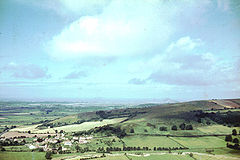Loxton, North Somerset
| Loxton | |
|---|---|
 Loxton from Crook Peak |
|
| Loxton shown within Somerset | |
| Population | 192 (2011) |
| OS grid reference | ST375555 |
| Unitary authority | |
| Ceremonial county | |
| Region | |
| Country | England |
| Sovereign state | United Kingdom |
| Post town | AXBRIDGE |
| Postcode district | BS26 2 |
| Dialling code | 01934 |
| Police | Avon and Somerset |
| Fire | Avon |
| Ambulance | South Western |
| EU Parliament | South West England |
| UK Parliament | |
Loxton is a village and civil parish in Somerset, England. It is close to the M5 motorway in the Unitary Authority of North Somerset. The parish includes the village of Christon and has a population of 192.
Loxton takes its name from the Lox Yeo River (once simply known as the Lox), on which it is situated. The village is mentioned in the Domesday book as Lochestone. The parish was part of the Winterstoke Hundred.
The village has been populated since Norman times. Old mine-workings on the hills indicate that at one time mining was abundant, probably for calamine, lead, copper and more recently yellow ochre.
During the construction of the M5 motorway a Roman or pre-Roman settlement was uncovered at Christon.
Christon Court has medieval origins, but the current building dates from the 17th century.
In 1954 the village came to national attention when Miss Noreen O'Connor, a nurse, killed Friederika Alwine Maria Buls by "plucking out" her eyes. She was tried for murder and found guilty but insane.
The parish council has responsibility for local issues, including setting an annual precept (local rate) to cover the council’s operating costs and producing annual accounts for public scrutiny. The parish council evaluates local planning applications and works with the local police, district council officers, and neighbourhood watch groups on matters of crime, security, and traffic. The parish council's role also includes initiating projects for the maintenance and repair of parish facilities, such as the village hall or community centre, playing fields and playgrounds, as well as consulting with the district council on the maintenance, repair, and improvement of highways, drainage, footpaths, public transport, and street cleaning. Conservation matters (including trees and listed buildings) and environmental issues are also of interest to the council.
...
Wikipedia

